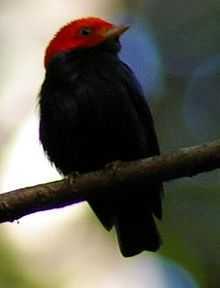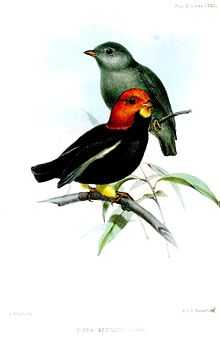Red-capped Manakin
| Red-capped Manakin | |
|---|---|
 | |
| Conservation status | |
| Scientific classification | |
| Kingdom: | Animalia |
| Phylum: | Chordata |
| Class: | Aves |
| Order: | Passeriformes |
| Family: | Pipridae |
| Genus: | Ceratopipra |
| Species: | C. mentalis |
| Binomial name | |
| Ceratopipra mentalis Sclater, 1857 | |
| Synonyms | |
|
Dixiphia mentalis | |
The Red-capped Manakin (Ceratopipra mentalis) is a species of bird in the Pipridae family. It is found in Belize, Colombia, Costa Rica, Ecuador, Guatemala, Honduras, Mexico, Nicaragua, Peru and Panama. Its natural habitat is subtropical or tropical moist lowland forests.
The bird is probably best known for the male's unusual courting method whereby it shuffles rapidly backwards across a branch, akin to a speedy moonwalk.
Taxonomy
The placement is disputed among taxonomists, with some including it in Pipra and others placing it in its own genus, Ceratopipra.)[3] It is closely related to, and in eastern Panama sometimes hybridizes with, the Golden-headed Manakin.[4]
There are three recognized subspecies:[5]
- P. m. mentalis, first described by Philip Lutley Sclater in 1857.[5]
- P. m. ignifera, first described by Outram Bangs in 1901.[5]
- P. m. minor, first described by Ernst Hartert in 1898.[5]
Description

The Red-capped Manakin is a small passerine, measuring 4 in (10 cm) in length[6][nb 1] and weighing 16 g (0.56 oz). The male is velvety black apart from a bright red head and nape, bright yellow thighs, and a pale yellow chin and wing linings.[6] The female is olive green above, with paler, more yellow-green underparts. Both sexes have dull brown legs. The male's irides are white, while those of the female and young are brown.[4]
While the adult male is distinctive, the female and youngsters can be confused with several similar species. The female Golden-collared Manakin is larger, and has orange (rather than brown) legs, while the female Blue-crowned Manakin is a brighter green (rather than olive).[4]
Habitat and range
Found primarily in humid forest and second growth woodland, the Red-capped Manakin typically occurs below 400–500 m (1,300–1,600 ft) above sea level, though it sometimes ranges as high as 900 m (3,000 ft).[4] Most are resident, but some individuals are known to migrate to take advantage of changing food resources: the number of Red-capped Manakins caught in mist nets at La Selva Biological Reserve, in eastern Costa Rica, tripled in January and February, when a favored fruit ripened, for example, while the number caught at a nearby higher elevation site (where the fruits were not found) dropped to zero.[7]
Behavior
Food and feeding
The Red-capped Manakin is a frugivore, feeding almost exclusively on fruits. These pass very quickly through the bird's digestive system, typically taking less than 18 minutes to process.[8] Seeds from a variety of plants are consumed; one study in Costa Rica found evidence of 70 species, including those from the genera Clidemia, Hampea, Henriettea, Leandra, Miconia, Ossaea, Pinzona and Psychotria, in the fecal droppings of Red-capped Manakins.[9]
Note
- ↑ By convention, length is measured from the tip of the bill to the tip of the tail on a dead bird (or skin) laid on its back.[1]
References
- ↑ Cramp, Stanley, ed. (1977). Handbook of the Birds of Europe, the Middle East and North Africa: Birds of the Western Palearctic, Volume 1, Ostrich to Ducks. Oxford University Press. p. 3. ISBN 0-19-857358-8.
- ↑ BirdLife International (2009). Pipra mentalis. In: IUCN 2008. IUCN Red List of Threatened Species. Retrieved 12 October 2010.
- ↑ Ridgely, Robert S.; Tudor, Guy (2009). Field Guide to the Songbirds of South America: The Passerines. Austin, TX: University of Texas Press. p. 692. ISBN 978-0-292-71979-8.
- ↑ 4.0 4.1 4.2 4.3 Hilty, Steven (1986). A Guide to the Birds of Colombia. Princeton, NJ: Princeton University Press. p. 430. ISBN 0-691-08372-X.
- ↑ 5.0 5.1 5.2 5.3 "Itis report: Pipra mentalis". Integrated Taxonomic Information System. Retrieved 21 February 2011.
- ↑ 6.0 6.1 Stiles, F. Gary; Skutch, Alexander F (1989). A Guide to the Birds of Costa Rica. Cornell University Press. pp. 299–300. ISBN 0-8014-9600-4.
- ↑ Hilty, Steven L.; Wolf, Mimi Hoppe (2005). Birds of Tropical America: A Watcher's Introduction to Behavior, Breeding, and Diversity. University of Texas Press. pp. 89–90. ISBN 0-292-70673-1.
- ↑ Bucher, Theresa L.; Worthington, Andrea (May–June 1982). "Nocturnal Hypothermia and Oxygen Consumption in Manakins". The Condor 84 (3): 327–331. doi:10.2307/1367377.
- ↑ Loiselle, Bette A.; Blendinger, Pedro G.; Blake, John G.; Ryder, Thomas B. (2007). "Ecological Redundancy in Seed Dispersal Systems: A Comparison Between Manakins (Aves Pipridae) in Two Tropical Forests". In Dennis, Andrew J; Schupp, Eugene W; Green, Ronda J. et al. Seed dispersal: theory and its application in a changing world. Wallingford, UK: CABI. p. 184. ISBN 978-1-84593-165-0.
External links
| Wikimedia Commons has media related to Ceratopipra mentalis. |
